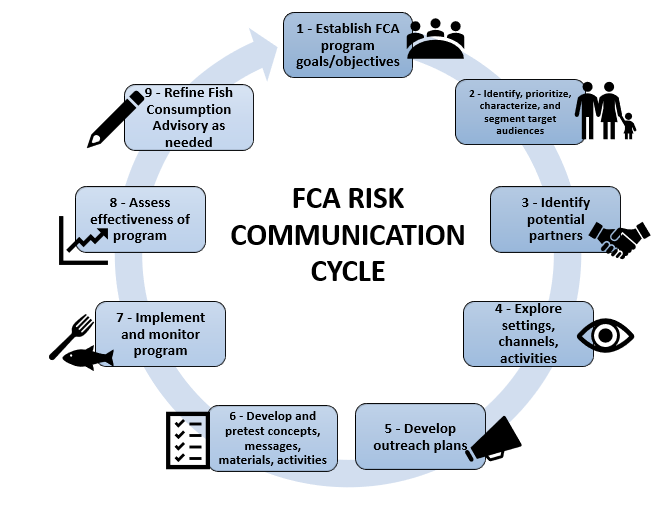7 - Implement and Monitor the Program
The seventh step for developing and implementing a risk communication program for fish and shellfish consumption advisories is to implement and monitor the program.
Introduction/Overview
Fish Consumption Advisory (FCA) managers should plan for distribution, promotion, and process evaluation. This includes developing a launch plan, producing sufficient quantities of materials, and preparing staff for the work ahead. Once the FCA program is implemented, monitor and evaluate the program.
Schedule for Implementation
After decisions have been made regarding the goals, audiences, messages, products, and distribution channels, develop an implementation schedule. For each product, consider how much time will be needed for development and distribution. Factor in sufficient time for product review. Wherever possible, build in time for testing and evaluation of representatives of the target audience in focus groups or individual sessions so that feedback can be obtained on whether the material has been effectively targeted to the target audience.
Seasonal Differences
Consider seasonal differences when developing and distributing FCA materials. It may be that fishing is more popular in a state, territory, or tribe during the summer months. However, there are many areas of the country where people fish year-round.
Program Launch
FCA programs can be launched quietly, starting activities on a limited basis in one geographic area or with just one partner to test the program. Using a limited approach will enable making adjustments before full implementation. This can be particularly useful for a large-scale program or for programs using a new technique or involving a new target audience. Another option is that the FCA program can be launched with a kickoff event.
Alternatively, a kickoff event can create broader awareness of the program and promote community involvement. Kickoff events are an excellent way to develop relationships with people who may be willing to get involved in the program. Scheduling an event also creates a deadline, which will help the program avoid unnecessary lag time or protracted preparations.
Managing Implementation: Monitoring and Problem Solving
Managing a FCA communication program is like managing any other project. Key activities include monitoring activities, staff, and budget; solving problems; evaluating the process; measuring target audience participation; and revising plans and operations.
-
Whether activities are being completed at scheduled times
-
Whether the target audiences are being reached
-
Which activities or materials are more successful than others
-
Which aspects of the FCA program need to be altered or eliminated
-
Whether the expenditures are within budget
Problems can often be corrected quickly once they are identified. For example, if the target audience is asked to call an agency number for more information, a simple form should be provided (electronic or manual) for telephone operators to use to record the questions asked and the answers given. Frequently review responses to identify inquiry patterns, to be sure that correct or adequate information is being given, and to find out whether more or different information may be needed. Another example is to have someone monitor an email box that is used for people to submit comments regarding what is posted online.
Process Evaluation
-
Messages being delivered appropriately, effectively, and efficiently
-
Materials being distributed to the target audiences and in the right quantities during a certain time period
-
Effectiveness of publicity, promotion, and other outreach efforts
-
Identification obstacles in reaching the target audience
-
Occurrence of intended program activities
-
Partner involvement
-
Target audience participation, inquiries, and other responses
-
Adherence to schedule and budget
-
Media response (if applicable)
How Target Audiences Can Help
- Members of affected communities and tribes will often be particularly well-positioned to help implement the advisory and outreach strategy that has been developed by and for their group. Members of affected groups will be active in or aware of community organizations, churches and other religious organizations, clubs, schools, and other entities that could play a role in getting the message out and facilitating risk communication.
- Members of target audiences will often be able to put together creative ideas for outreach – a product of their knowledge of norms in the community or tribe; their on-the-ground connections; their shared experience – especially, shared practices exposing them to environmental risks; and their involvement in prior organizing efforts.
- Members of target audiences will likely know which community festivals, ceremonies, or events are likely to be well-attended and appropriate venues for outreach.
- Implementation by target audience members may also facilitate environmental justice along multiple dimensions. In addition to capacity-building, looking to affected groups for implementation may enable them to dovetail efforts regarding fish consumption with other health and environmental outreach efforts (e.g., regarding possible contaminants in breast milk, the value of Native foods in countering diabetes, or nutrition in general).
-
Risk Communication in Action: The Risk Communication Workbook (PDF) (75 pp, 15 MB) (EPA, 2007)
-
Fish Consumption and Environmental Justice (2002) (PDF) (185 pp, 2 MB, About PDF)

